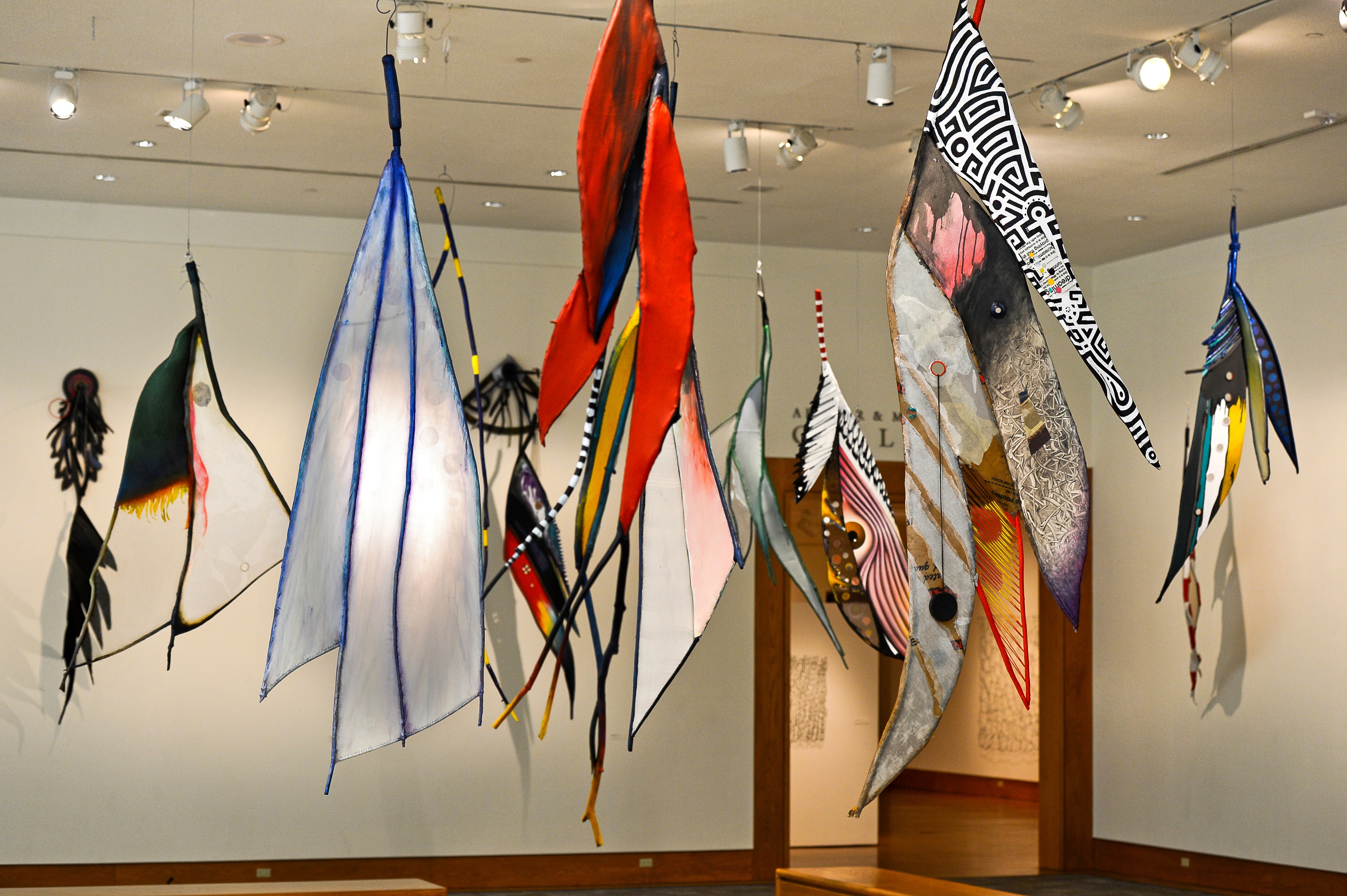First solo exhibition at the Oliver Art Center opens May 30
The Oliver Art Center’s first solo exhibition, featuring the work of artist Rufus Snoddy, will open May 30, with a reception to be held Friday, June 13, from 5-7 p.m.
“Rufus’ powerful and unforgettable ‘construction paintings’ have been on our radar for years,” says Art Center director Steve Brown on Snoddy’s selection as the inaugural solo artist. “More recently, Snoddy’s exhibition at the Dennos Museum [in Traverse City] gave us a chance to connect with him regarding his broader body of work. Beginning on May 30, we will be presenting various works spanning the past 20 years of his career, including the astonishingly beautiful sculpture installation titled The Wings of Icarus.”
Snoddy says that this installation, which first appeared at the Denoos Museum Center in March 2013, was inspired by the mythological story of Icarus.
“I utilized materials from my immediate environment—tree branches from the woods of Northern Michigan, found and fabricated objects, as well as traditional media and materials—to create visual metaphors,” says Snoddy. “Daedalus, the father of Icarus, also used materials in his immediate environment—wax from candles, string, bird feathers and wood—to make two sets of wings for him and his son to escape from the Prison of Minos in the Greek island of Crete. These works are visual personifications of the hypothetical question ‘If you or I were Daedalus and Icarus, and we had to make wings to escape from the Prison of Minos, what would our wings look like?’”
The Dennos show was meant to hang until June of last year, but museum director Eugene Jenneman says that “when the show was technically scheduled to close, there was little interest [in dismantling it.] It just held the space so wonderfully.” The Wings of Icarus only came down recently, Jenneman says, when the staff realized that it would visually conflict with works by the Tibetan monks, who would be doing a sand painting in the space. “[Snoddy’s was] probably one of the longest running solo exhibitions we’ve had in the Museum. Rufus is an outstanding artist, and he provided a fresh visual perspective. It stretched him—let him stretch his wings, if you will—and it worked so well within the space. It was the perfect exhibition to do here.”
Brown is excited to bring Snoddy’s Wings to Frankfort. “We will be working particularly hard to ensure that we exploit the unique aspects of space and natural light in our Beck and Borwell Galleries,” Brown says. “His work and output is tremendous, and we are very thrilled and honored to host him this year. He is also a superlatively kind and charming person, and we look forward to celebrating the opening reception with him on Friday, June 13. What’s more, Rufus’ free artist talk from 6-7 p.m. on Friday, June 27, will give people a chance to hear about Rufus’ work in his own words.”
In addition to Wings, the Oliver Art Center will feature work spanning several decades of Snoddy’s career. His art is playful and adventurous, bold in color and texture, and even his paintings are sculptural. In his wall-hung work Time Fragments, (acrylic on canvas, paper, wood, metal, and plastic; view it online at SnoddyArt.com), there are textures reminiscent of skin and fish scale; a body shape that echoes both guitar and reef creature; and a mastery of line, color, pattern, and contrast. In his Disappearing Man, Contemplating Devilled Eggs (acrylic on canvas and mixed media) even the border, or frame, is alive with colorful shapes twisting and climbing and braiding into one another. Snoddy’s ethos is one of harmonious play and experimentation, balance and proportion, meant to engage a viewer’s mind, and to inspire wonder and emotion, surprise and discovery.
“I have so many ideas,” Snoddy says. “I take inspiration from everywhere. I’m influenced by nature, and by my travels, and by other cultures, especially indigenous cultures. It’s very hard, I feel like I don’t have enough time to do all these things justice.”
Snoddy received his BA in Design in 1973, and a Fine Arts Master’s degree in 1976, both from California State University, Los Angeles. His curriculum vitae—a continuous cross-country and international exhibition record reaching back to the early 1980s—stands as evidence of Snoddy’s unwavering commitment to a less-trodden career path.
He credits his success, and his confidence to stick with an artistic life, to his parents, Rufus and Catherine Snoddy—“a poor but proud couple who spent their lives working menial jobs to support their large family.” The 10th of 12 children, Snoddy was very close to his father, who was forced to leave school after the death of his own father.
“Education was very important to him, pushing yourself. And being one of the last kids, I just wanted to make him proud,” says Snoddy, who showed an interest in drawing at age 4. “My mother was so proud of it. That just made me want to do it more and more.”
Despite his early artistic inclinations and family support, Snoddy almost didn’t become an artist. After one of his pieces was rejected from an eighth grade show, he gave up art to focus on athletics. Not until college, just a few credits shy of a degree in physical education, did he realize that he wasn’t going to be satisfied with a career as a gym teacher or a coach. He sat thinking on a park bench for over an hour, then got up and walked into the art department building and began his college career over again. And, he says, “I never looked back.”





Wonderful writing Jenny. Thank you!